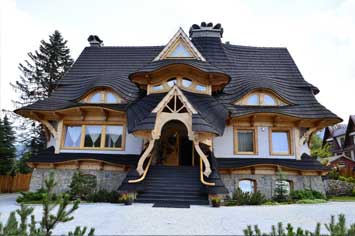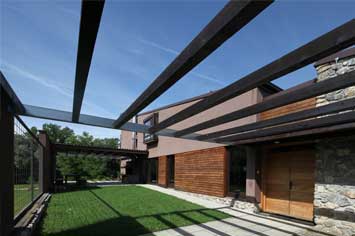Separating the self-build dream from the fantasy
When we begin a project like self-building our own home, influences abound. Sometimes, these influences have the power to change our perspective of what a self-build project can be and what its final purpose is. This can push us to design and build something truly unique. But often it can also blur the line between “strong, secure home for life” and “strong creative statement”. Is this preventing more people in the UK from self-building their own homes?
Making a personal statement
 Should we always be able to recognise a self-built home?
Should we always be able to recognise a self-built home?
It’s not a crime to believe so. For many the greatest exposure to the self-build experience is in the form of architectural homebuilding television programmes.
These programmes are designed to entertain and educate, and more often than not they inspire viewers with the freedom of designing and constructing their own home.
But are would-be home-builders being shown self-building through a keyhole? What we rarely ever see is the self-building of a home that isn't designed to amaze or make a strong architectural statement. A self-build is still a home at the end of the day – one that requires maintenance, protection and insurance – so is it wrong to self-build a traditional house?
Can traditional be unique?
 Self-building is something of a paradox, especially in the UK. On the one hand you have the permanence and dependability of owning your own home. A person’s home is their castle, and exists to protect them and keep them secure. But on the other hand you have the once-in-a-lifetime opportunity of building your castle with your own hands (or with the help of contractors).
Self-building is something of a paradox, especially in the UK. On the one hand you have the permanence and dependability of owning your own home. A person’s home is their castle, and exists to protect them and keep them secure. But on the other hand you have the once-in-a-lifetime opportunity of building your castle with your own hands (or with the help of contractors).
One large factor contributing to this paradox is that self-building is still strikingly uncommon in the UK, especially compared to the rest of Europe. Self-built homes currently make up between 7-10% of completions in the UK. For Austria that number is closer to 80%. This is despite the fact that a Building Societies Association (BSA) survey published in October 2011 stated that 53% of people in the UK would consider building their own home if given the chance.
This unmet demand has bred a view of the self-built home as a rare luxury. Even the concept of insuring a self-build project and the resulting property is a mystery to many. So it’s understandable that when given the “rare” opportunity, the gut instinct is to exploit it to make something truly unique. But does that mean you need to make something experimental for the sake of it?
Many people may feel like self-building isn't for them because it's been presented to them as a full-blown creative endeavour. Perhaps they don't have a scrapbook of floor plans or doodles of the perfect open fireplace illuminating exposed oak beams. Perhaps all they've wanted to do is build the same kind of house they grew up in; the kind of house that made them feel safe and protected. Why should that stop them from self-building? The truth is it shouldn't.
A return to form
There are more options available than ever to self-build traditional homes. Right to build is tailored to the traditional build style, and should pave the way for a less extravagant spectrum of homemade homes. Local authorities are required to try and meet the demand of the self-build register by providing the proper permissions for plots of land. These authorities even provide guidance on finding plots and insuring your self-build. The demand for self-builds en masse is there, and the supply should follow in turn.
Self-building in the UK can often be a victim of its perceived luxurious image. A self-build home project isn't a wedding: a bold demonstration of the self. It's a marriage: a long-lasting, protective relationship between homeowner and home. Yes it can be one of a kind, but it can also be traditional, nostalgic and simple.
Protecting your project
One way of getting a wider perspective of building your own home is getting to grips with the logistics. That includes understanding what is required when it comes to insuring both your project and the resulting property. Whatever your self-build looks like, you always want to ensure it’s protected with the right insurance.
Below we’ve outlined the key risks that you should be insured for:
 Injury to members of the public – Whether passers-by, visitors to the site or even a trespasser, it is your responsibility to have Public Liability cover in place.
Injury to members of the public – Whether passers-by, visitors to the site or even a trespasser, it is your responsibility to have Public Liability cover in place.
 Injury to workers on site – You have responsibilities for workers that you employ on the site, and the law requires you to have Employers’ Liability insurance in case these workers are injured during the course of their work on site.
Injury to workers on site – You have responsibilities for workers that you employ on the site, and the law requires you to have Employers’ Liability insurance in case these workers are injured during the course of their work on site.
 Personal accident – Consider protecting yourself should you sustain a permanent disability, such as loss of limbs, while on site.
Personal accident – Consider protecting yourself should you sustain a permanent disability, such as loss of limbs, while on site.
 Personal belongings – If you’re storing any of your belongings on site whilst you complete your build, you should make sure these are covered too, but you’ll need to maintain appropriate security to prevent theft.
Personal belongings – If you’re storing any of your belongings on site whilst you complete your build, you should make sure these are covered too, but you’ll need to maintain appropriate security to prevent theft.
 Theft of tools or plant from the site – Whether these are owned by you or have been hired-in, they can be expensive to replace. You will of course be expected to maintain a high level of site security.
Theft of tools or plant from the site – Whether these are owned by you or have been hired-in, they can be expensive to replace. You will of course be expected to maintain a high level of site security.
 Contract Works cover – Contract Works cover protects the property whilst under construction including materials on site. Accidental damage, storm damage, vandalism, flooding and fire are all risks to be aware of.
Contract Works cover – Contract Works cover protects the property whilst under construction including materials on site. Accidental damage, storm damage, vandalism, flooding and fire are all risks to be aware of.
 Legal Disputes – Make sure you have protection against any potential legal costs arising from contractual disputes between you and your contractor, utility companies, or the removal of squatters from site during the course of the build.
Legal Disputes – Make sure you have protection against any potential legal costs arising from contractual disputes between you and your contractor, utility companies, or the removal of squatters from site during the course of the build.
Top Tips
 Get self-build cover in place as soon as you have a plot and have begun the planning process, as you may be liable for damage, loss or injury.
Get self-build cover in place as soon as you have a plot and have begun the planning process, as you may be liable for damage, loss or injury.
 Don’t assume that your contractor’s insurance will cover the whole project. This is not always the case. A contractor’s Public Liability policy does not cover your property in the event of storms, fire or theft, or should visitors be injured whilst on your site.
Don’t assume that your contractor’s insurance will cover the whole project. This is not always the case. A contractor’s Public Liability policy does not cover your property in the event of storms, fire or theft, or should visitors be injured whilst on your site.
 Make sure you have comprehensive cover to include Public Liability, Employers’ Liability, building works, legal costs, on site temporary structures, and machinery/tools whether hired-in or owned.
Make sure you have comprehensive cover to include Public Liability, Employers’ Liability, building works, legal costs, on site temporary structures, and machinery/tools whether hired-in or owned.
Contact us today on T. 0800 230 0225 to speak to one of our helpful team to gain extra peace of mind that your project is in safe hands, or visit us at www.selfbuild.uk.com.